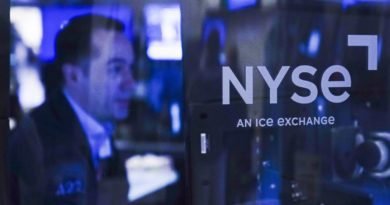Late Slide Sends Wall Street Lower in More Uncertain Trading
Distressed Patriotic Flag Unisex T-Shirt - Celebrate Comfort and Country $11.29 USD Get it here>>

A wobbly day of trading on Wall Street ended with a modest pullback for stocks Wednesday as investors weighed a report showed that inflation remains very hot, likely paving the way for more aggressive interest rate hikes by the Federal Reserve.
A late-afternoon drop erased tentative gains that the major stock indexes had been clinging to for much of the day. The S&P 500 ended 0.3 percent lower, its sixth consecutive loss. The Dow Jones Industrial Average and the Nasdaq composite each slipped 0.1 percent.
Treasury yields, which have driven much of Wall Street’s recent trading, ended lower. The yield on the 10-year Treasury, which affects mortgage rates, fell to 3.90 percent from 3.95 percent late Tuesday. The yield on the 2-year Treasury slipped to 4.28 percent from 4.30 percent.
The market remained choppy following the afternoon release of the minutes from the Fed’s last interest rate policy meeting. The minutes underscored the central bank’s commitment to taming “unacceptably high” inflation. At the conclusion of that meeting last month, the Fed announced a hefty interest rate hike and signaled more large rate increases ahead.
“The Fed minutes didn’t contain a lot of new information, but they did reiterate their intention to erring on the side of doing too much, rather than too little,” said Chris Zaccarelli, chief investment officer at the Independent Advisor Alliance.
The S&P 500 fell 11.81 points to 3,577.03. The benchmark index is down about 25 percent so far this year and is close to its lowest point in nearly two years.
The Dow dropped 28.34 points to 29,210.85, while the Nasdaq slipped 9.09 points to 10,417.10. The indexes are on pace for a weekly loss.
Utilities, technology companies and health care stocks weighed on the market, keeping gains elsewhere in check. Duke Energy fell 4 percent, Texas Instruments slid 1.2 percent and Abbott Laboratories closed 1.6 percent lower.
PepsiCo rose 4.2 percent after raising its profit forecast for the year following encouraging quarterly financial results.
Cruise line operators were among the biggest gainers in the S&P 500. Carnival rose 10.1 percent, Norwegian Cruise Line gained 11.6 percent and Royal Caribbean climbed 11.5 percent.
Small company stocks also lost ground. The Russell 2000 index fell 5.15 points, or 0.3 percent, to 1,687.76.
Markets have been volatile all week as investors wait for the latest round of big company earnings reports and fresh reports on inflation and retail sales.
A report from the government showed that inflation at the wholesale level eased last month, though it was a bit worse than economists expected. A more closely watched component of the inflation data matched economists’ forecasts.
Inflation updates are being closely watched by investors who worry that stubbornly high prices on everything from food to clothing could lead to a recession. Those worries have been worsened by central banks around the world raising interest rates to make borrowing more expensive and slow economic growth.
The Federal Reserve has been particularly aggressive, and its strategy carries the risk of stalling an already slowing economy and causing a recession.
In the minutes from the central bank’s Sept. 20–21 meeting, Fed policymakers judged that a “softening of the labor market’’—likely including higher unemployment—would be needed to curb the nation’s inflationary pressures. They noted that hiring remained “robust,” which itself fuels high inflation as wages rise sharply.
A closely watched report on consumer prices is due Thursday and data on retail sales for September is due Friday. Both reports could help give Wall Street a clearer picture of where prices remain hottest and how consumers are reacting.
The corporate earnings season begins in earnest this week. Domino’s Pizza and Walgreens will report their results on Thursday. Big banks, including Citigroup and JPMorgan Chase, will report results on Friday.
The British pound weakened against the U.S. dollar after the governor of the Bank of England, Andrew Bailey, confirmed the bank will not extend beyond Friday an emergency debt-buying plan introduced last month to stabilize financial markets.
Markets in Europe mostly fell.
The U.S. dollar has been gaining strength relative to other currencies amid increased recession fears. The Japanese yen declined to a 24-year low against the U.S. dollar to 146 yen-levels, raising expectations of an intervention to prop up the yen following one such move in September.
By Damian J. Troise and Alex Veiga





